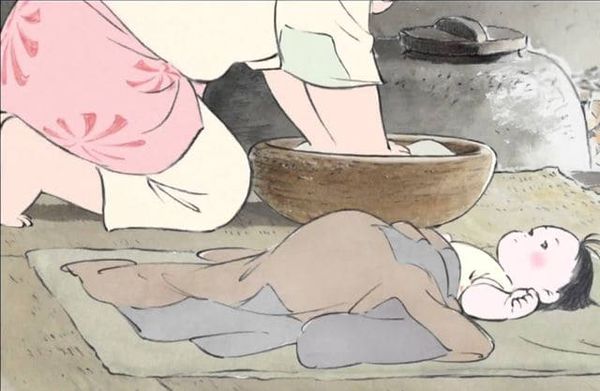Eye For Film >> Movies >> The Tale Of Princess Kaguya (2013) Film Review
The Tale Of Princess Kaguya
Reviewed by: Owen Van Spall

With Japanese animation powerhouse Studio Ghibli due to take a hiatus of uncertain duration following the retirement of founder Hayao Miyazaki, The Tale Of Princess Kaguya will be, for western audiences, the penultimate film from that studio for some time (When Marnie Was There is still to come). This new animated feature film is directed by Ghibli veteran Isao Takahata (Grave Of The Fireflies, Pom Poko), one of the old guard at the studio and the original co-founder of the venture alongside Miyazaki. Whether the studio can survive his inevitable retirement (he is 78 years old) and Miyazaki’s too is an open question, but if Kaguya is a swan song, it is a great note to go out on.
Takahata’s new film shares much DNA with Ghibli’s previous output. The studio has always prided itself on not sacrificing that handmade feel in its visual styles from film to film in the digital era, and Kaguya is an extreme example of that. The animation approach mimics the effects of pencil and calligraphy brushes, which gives it the look of a child’s picture book or a half-complete watercolour landscape canvas, and this feels more than appropriate given the film’s plot is based on Japanese folk story The Tale of the Bamboo Cutter, from the 10th century. There is a young, feisty female heroine at the centre of things, which is another Ghibli hallmark.

The story is a timeless one of youthful desire versus duty and hard life lessons, though some of the elements drawn from Japanese mythology and folklore might confuse some viewers. The titular princess is a woodland sprite, discovered in a bamboo forest encased in a flower by a poor Japanese woodcutter in 17th century Japan. Magically growing in size and intelligence in mere months, the woodcutter believes such a miracle child can only be a princess given to them by heaven, though his kindly wife is more concerned with down-to-earth matters such as feeding and clothing the child. Deciding to take her in as their own, the couple go on to raise the girl in a happy home and allow her to bond with and play rough and tumble with the youngsters who live nearby. They call her “Princess”, the full name “Princess Kaguya” being bestowed on her later.
Things take a darker turn, and this rural idyll is disturbed, when matters of money and status enter the picture. The woodcutter discovers a pile of treasure in the forest near to where he found the girl, leading him to believe the desire of the gods is that the money be used to set themselves up as some kind of royal family, living in splendour in the capital. The energetic and mischievous Princess is promptly spirited off to a newly built mansion in the capital and educated in the ways of a lady, something that rubs her up the wrong way. But hovering in the background is her fear that this new found wealth is swarming in her father's mind, and that the strange forces that sent her to earth might one day reclaim her.
This intrusion into a rural paradise - where nature and humanity exist in greater harmony - and the sadness and emotional torment that results, is a theme frequently woven into Ghibli films, such as Nausicaa: Valley of the Wind. Princess is shown to be more than happy scampering about in the forest, especially with her friend Sutemaru, and her refusal to knuckle under to the snotty tutors once she is installed in the gaudy mansion results in many moments of comic relief. The film also gives space to show Princess’s intelligence and determination in the face of objectification and misogyny, as in one scene where she bamboozles a procession of arrogant suitors by demanding they actually carry our their crazy boasts before they can claim her hand. She is a torn figure, desperate to return to the simple village where she grew up, but also hesitant at the thought of ruining her father’s hopes for her, even as it becomes clearer that he is more concerned for his own status than his daughter’s happiness.
Playful, cantankerous and tough, Princess joins a long line of likeable and independent-minded Ghibli female leads that includes Chihiro from Spirited Away, Sophie from Howl’s Moving Castle, and Kiki from Kiki’s Delivery Service. In terms of the animation, Princess is an undeniably exquisite and graceful creation; when she flips her thick hair, the effect is that of an artist’s brushstroke or a swoosh of charcoal. There is a minimalist feel to the look of the film’s characters and locations, but it is surprising how much emotion comes through via the gestures and facial expressions.
Gently paced, the film gives enough time to Princess’s journey and the relationship with her family and friends so that the result stands as more than just a retro visual trick. There is real emotional heft contained within this tale of one girl who learns the value of both love and pain and how they inevitably have to co-exist within a short life. The relatable, compassionately told story should easily appeal to both adults and younger folk. It is perhaps a little too long (it lasts nearly two-and-a-half hours) for something so unhurried, but if this Takahata’s final film, what a way to go out. Its nomination for the 2015 Academy Awards was well-deserved.
Reviewed on: 15 Mar 2015

















